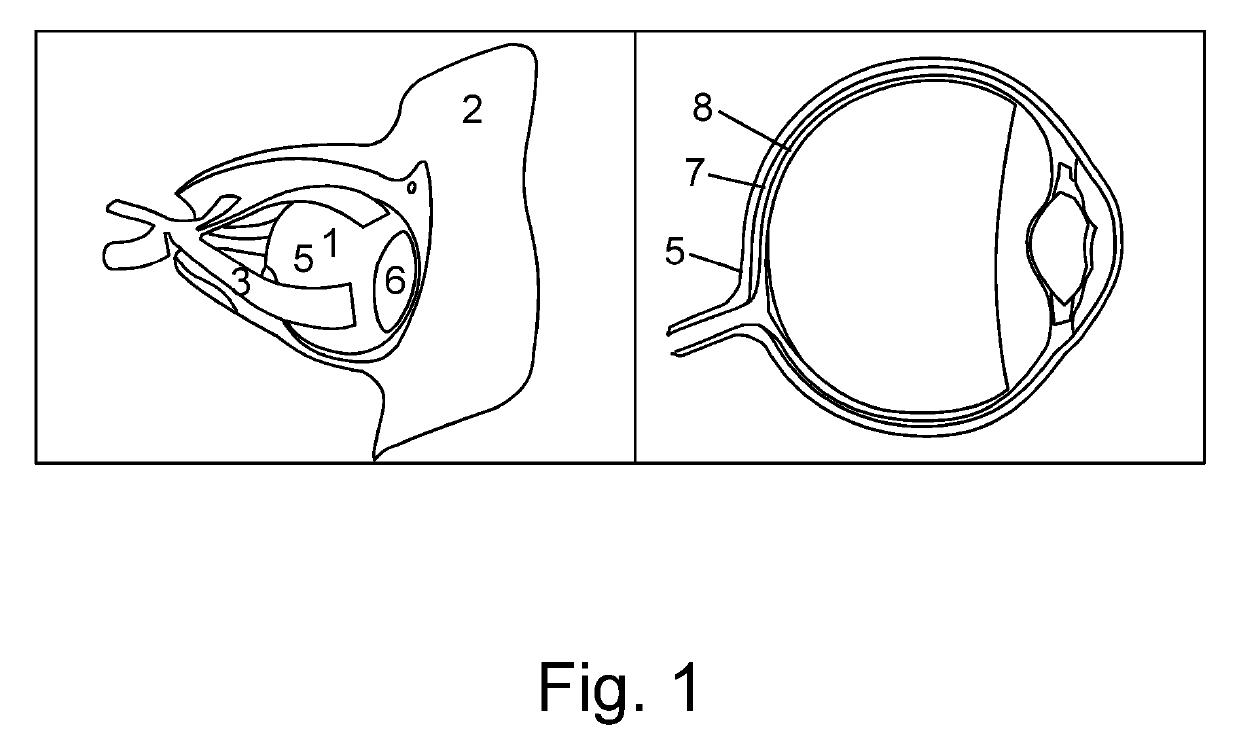Device for a medical treatment of a sclera
a technology for sclera and medical treatment, applied in the field of substance application and irradiation system, to achieve the effect of increasing scleral stiffness, minimizing the biomechanical stability of the sclera, and changing the biomechanical properties of the tissu
- Summary
- Abstract
- Description
- Claims
- Application Information
AI Technical Summary
Benefits of technology
Problems solved by technology
Method used
Image
Examples
example 1
Procedure in Rabbit Experiments
[0367]To perform the riboflavin / blue light collagen crosslinking the animals were anesthetized by an intramuscular injection of ketamine hydrochlorid (50 mg / kg body weight weight; Ketamin 5%, Ratiopharm, Ulm, Germany) and xylazinhydrochlorid (10 mg / kg body weight; Rompun; Bayer Vital GmbH, Leverkusen, Germany). For maintenance of the anaesthesia Ketamine hydrochloride (25 mg / kg body weight) and xylazinhydrochlorid (5 mg / kg body weight) were injected intramuscular. Only the right eye underwent treatment whereas the contralateral untreated eye served as individual control. For avoiding corneal damage while surgery the left eye was treated with Floxal® eye ointment (Dr. Gerhard Mann GmbH, Berlin, Germany). Conjuncain was additionally used for local anaesthesia of the right eye. After temporal canthotomy the conjunctiva was incised at the limbus to open the Tenon's space. Then Tenon's space was bluntly dissected in the superior temporal quadrant. The super...
example 2
nt of Riboflavin Penetration in Scleral Tissue
[0368]FIG. 11 displays the mean time period of the total tissue penetration of Riboflavin in scleral patches from various species. The penetration time was calculated by an application of riboflavin onto one side of a scleral tissue patch and the total appearance on the opposite side monitored as a maximum of fluorescence by a fluorescence microscope. Compared to 10-20 minutes in rabbit sclera, it takes approximately 30-40 minutes for riboflavin to penetrate the human sclera. Frozen / thawed scleral tissue was used for this examination; however, the results were similar with freshly isolated (i.e. non-frozen) tissue.
[0369]FIG. 12 demonstrates the spectral light transmissibility characteristics of scleral tissue from various species. Approximately only 0.5-1% of the light (up to 500 nm wavelength) penetrates the scleral tissue of all species. The application of riboflavin reduces the transmissibility further at wavelength up to 530 nm cause...
example 3
f Sclera Crosslinking in Different Species
[0371]FIG. 14: Light microscopy of histological semi-thin sections (0.5 μm thickness, Toluidin blue staining) to compare the dimensions and structure of scleral tissue from various species. The scale bar in A (macaque) sclera is valid for all scleral sections in A and demonstrates the differences of thickness in the posterior part of the sclera. B shows histological sections at higher magnification to reveal structural differences. The histological examinations revealed large structural similarities between rabbit and human sclera and differences in comparison to other species. The scale bar in B (macaque) sclera is valid for all scleral sections in B.
[0372]FIG. 15: Comparison of morphological properties of acute isolated (A) and frozen / thawed (B-D) scleral tissue with (C and D) and without (A and B) crosslinking treatment. Microphotographs display histological semithin sections of scleral tissue visualized by light microscopy (Toluidin blue...
PUM
 Login to View More
Login to View More Abstract
Description
Claims
Application Information
 Login to View More
Login to View More - R&D
- Intellectual Property
- Life Sciences
- Materials
- Tech Scout
- Unparalleled Data Quality
- Higher Quality Content
- 60% Fewer Hallucinations
Browse by: Latest US Patents, China's latest patents, Technical Efficacy Thesaurus, Application Domain, Technology Topic, Popular Technical Reports.
© 2025 PatSnap. All rights reserved.Legal|Privacy policy|Modern Slavery Act Transparency Statement|Sitemap|About US| Contact US: help@patsnap.com



